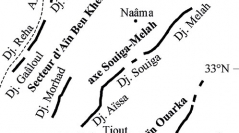

 Comptes Rendus Palevol
6 (3) - Pages 189-196
Comptes Rendus Palevol
6 (3) - Pages 189-196The micropalaeontologic analysis of the Lower Toarcian from the Ksour Mountains (western Saharan Atlas, Algeria) allows us to recognize several assemblages of benthic foraminifera and to obtain information about the deposit environment. These assemblages dominated by Nodosariids are organized in four successive stages of settlement (normal, survival, extinction, and repopulation). This distribution gives new information on the environmental conditions and on their effect on the change in the vertical distribution of benthic foraminifera. The quantitative evolution documents a progressive deepening of the environment that is controlled by local tectonic and sedimentary dynamics. The result is an ecosequence depending both on the general sea-level rise and on a progressive confinement of the bottom water. The normal stage occurred at the beginning of the Polymorphum zone; uncoiled and small sized Nodosariids species indicate the opening of the Atlasic furrow. After, during the middle of this zone, these species were associated with Polymorphinids and Ceratobuliminids, which indicate a deep but isolated and confined environment (survival stage). The ecosequence ended with an episode without foraminifera; it is the extinction stage dated in the Polymorphum and Early Levisoni zones. This stage corresponds to an umbilicus setting. Such palaeophysiographic conditions exaggerated the general coeval hypoxy, responsible of the main Toarcian crisis. Then, from the late Levisoni zone to the end of the Middle Toarcian, the ecosequence evolution is inverted, as a consequence of the filling of the deep parts of the umbilicus, which were less partitioned and more oxygenated (repopulation stage).
Ksour Mountains, Algeria, benthic foraminifera, communities, Anoxy, Early Toarcian